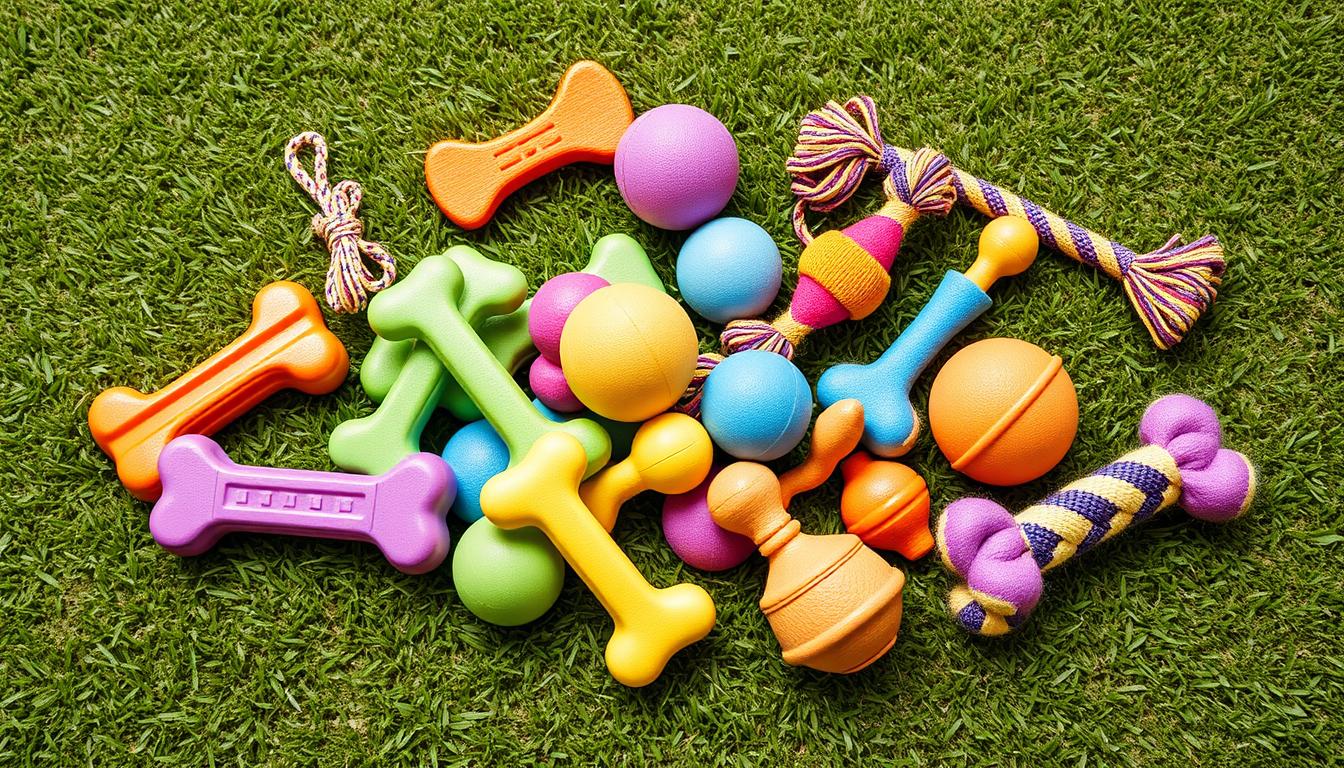As a new pet owner in Australia, you might find excessive puppy chewing frustrating. But, it’s a normal part of their growth. Puppies chew for many reasons, like easing teething pain, exploring, and playing.
Chewing is natural, but you can guide them to chew on the right things. This way, you can protect your belongings from damage.
Ever thought, “How can I stop my puppy from chewing on everything?” This article will show you how to stop excessive chewing and keep your home safe. You’ll learn about the best chew toys and positive training methods to help your puppy.
Key Takeaways
- Excessive puppy chewing is a normal behaviour, but it can be managed with the right approach.
- Providing appropriate chew toys and rotating them regularly can help satisfy your pup’s natural urge to chew.
- Positive reinforcement training is more effective than punishment in preventing destructive chewing habits.
- Ensuring your puppy receives adequate physical and mental exercise can help reduce boredom and curb chewing behaviour.
- Supervising your puppy and restricting access to certain areas can help prevent mistakes and set them up for success.
Understanding Puppy Chewing Behaviour
Puppy chewing is a normal, instinctual behaviour. It serves several important purposes. When puppies are teething, they chew a lot to relieve pain and discomfort.
Teething Pain
During the puppy teething phase, chewing helps ease teething discomfort. This natural behaviour is crucial for their physical and mental health.
Natural Exploration
Puppies explore their environment by chewing on new objects. This puppy exploration behaviour helps them learn about their surroundings.
Play Behaviour
Chewing is also a form of puppy play behaviour. It helps strengthen their jaws and teeth. This play-based chewing is vital for their development.
Understanding the reasons behind puppy chewing is key. It helps develop effective management and training strategies.
| Chewing Cause | Explanation | Statistical Data |
|---|---|---|
| Teething Pain | Puppies chew excessively to relieve the discomfort of losing their baby teeth and growing permanent adult teeth. | Puppy teething phase usually ends by six months of age. |
| Natural Exploration | Puppies put new objects in their mouths to gather information about texture, taste and consistency. | Both wild and domestic dogs spend hours chewing bones to keep their jaws strong and teeth clean. |
| Play Behaviour | Chewing helps strengthen a puppy’s jaws and teeth as part of their natural play behaviour. | Chewing behaviour is considered normal for dogs and plays a crucial role in maintaining their physical and mental health. |
“Puppies and adult dogs should have a variety of appropriate and attractive chew toys to discourage inappropriate chewing behaviours.”
Ruling Out Underlying Issues
Excessive puppy chewing is normal, but it’s important to find and fix any underlying causes. These can range from separation anxiety to hunger. Let’s look at some common triggers and how to tackle them.
Separation Anxiety
Puppies with separation anxiety chew a lot when left alone. They might damage furniture, clothes, and more. It’s vital to train them and help them get used to being by themselves.
Fabric Sucking
Some puppies suck on fabrics due to being weaned too early. This can lead to chewing on clothes, blankets, or furniture. Giving them the right chew toys and fixing this habit is key.
Hunger
Hunger can make a puppy chew on things to eat. Make sure they get the right food and eat regularly. This helps stop them from chewing on things they shouldn’t.
By tackling these issues, you can help your puppy stop chewing too much. Remember, training a young pup takes patience and consistency.
Managing Chewing Through Puppy-Proofing
To stop puppy chewing, make a safe, dog-safe environment. Pick a puppy-proof area with chew toys, bedding, and water. Also, take away things that might tempt them to chew.
When you can’t watch them, keep them in this safe spot. This stops them from chewing on things they shouldn’t. It’s important to make it easy for them to choose the right things to chew.
Puppies have 28 baby teeth and 42 permanent ones. They chew because of teething, natural exploration, and play behaviour. Good puppy-proofing helps stop bad chewing during this important time.
- Designate a confined, puppy-proof area with appropriate chew toys, bedding, and water.
- Remove any valuable or potentially dangerous items the puppy could target.
- Confine the puppy to the secure space when you can’t actively supervise them.
- Make it easy for the puppy to succeed by removing temptations.
Good puppy-proofing is key to managing chewing. It makes a safe, dog-friendly environment for your puppy to grow and thrive.
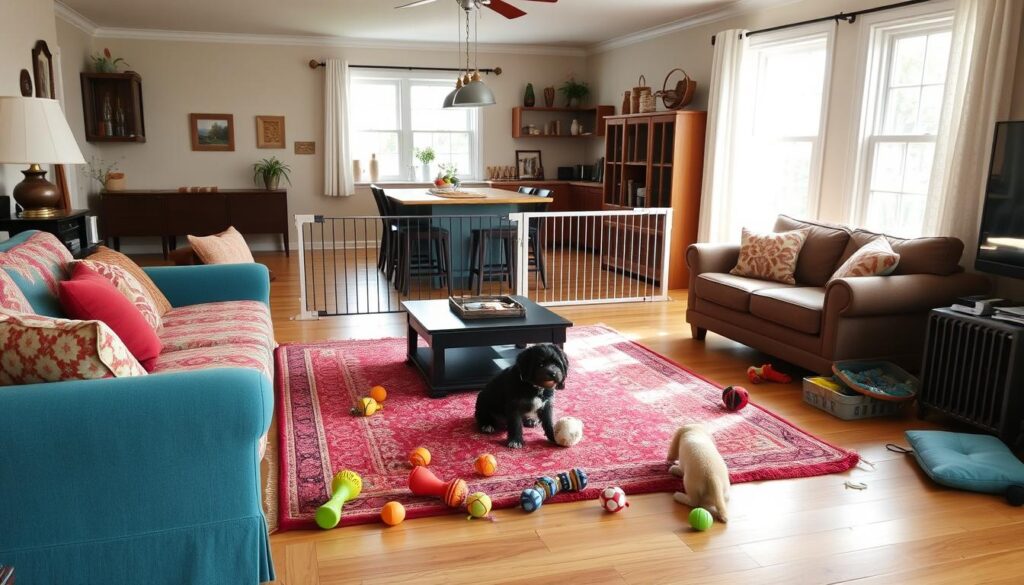
“Puppy chewing is a natural part of growing up, with puppies between 3 to around 8 months of age often having teeth coming in, which can affect around 12.5% of a dog’s first year.”
Providing Appropriate Chew Toys
As you work to puppy-proof your home, it’s key to give your furry friend safe chew toys. These toys meet your puppy’s need to chew and help with teething pain. They also stop boredom from leading to destruction.
Selecting Safe Toys
When picking puppy chew toys, choose the right size and type for your puppy’s teeth. Soft, rubber safe chew toys like KONG toys are great. They won’t hurt your puppy’s teeth. Natural chews, like bully sticks or rawhide, are also good, but watch your puppy to avoid swallowing hazards.
Rotating Toys
To keep your puppy interested, change the toys often. New and different enrichment toys keep your puppy curious and excited for play. This stops destructive chewing by offering a constant stream of new things to explore.
| Toy Type | Purpose | Recommended Rotation |
|---|---|---|
| Soft, rubber chew toys | Teething relief, mental stimulation | Weekly |
| Natural chews (bully sticks, rawhide) | Chewing satisfaction, dental health | Every 2-3 days |
| Interactive toys (puzzle feeders, snuffle mats) | Problem-solving, mental enrichment | Every 3-4 days |
By offering a variety of puppy chew toys and changing them often, you meet your puppy’s chewing needs. This prevents destructive behavior and boosts their overall health.
Solutions for Excessive Puppy Chewing
Stopping puppies from chewing too much needs a few steps. Puppies chew a lot when they’re teething or exploring. It’s important to give them safe things to chew on.
Changing toys and chew bones often helps prevent boredom chewing. A bitter spray can also stop them from chewing on things they shouldn’t. Crate training or doggy daycare helps when they’re left alone.
Keeping puppies active and mentally stimulated is key. They need lots of exercise and play. Puppies without siblings might chew more, so giving them the right toys and praising them helps.
If your puppy chews too much, get help from a vet or a trainer. They can give you advice and help your puppy learn good habits.
| Chewing Behaviour | Typical Timeline |
|---|---|
| Teething Phase | Typically occurs until all adult teeth are in, usually around 5-6 months of age. |
| Development Phase | Can start in late puppyhood (around 7-8 months) and may last up to 2 years. |
| Adolescent Chewing | Puppies may exhibit destructive chewing behavior, likened to teenagers needing to be kept busy. |
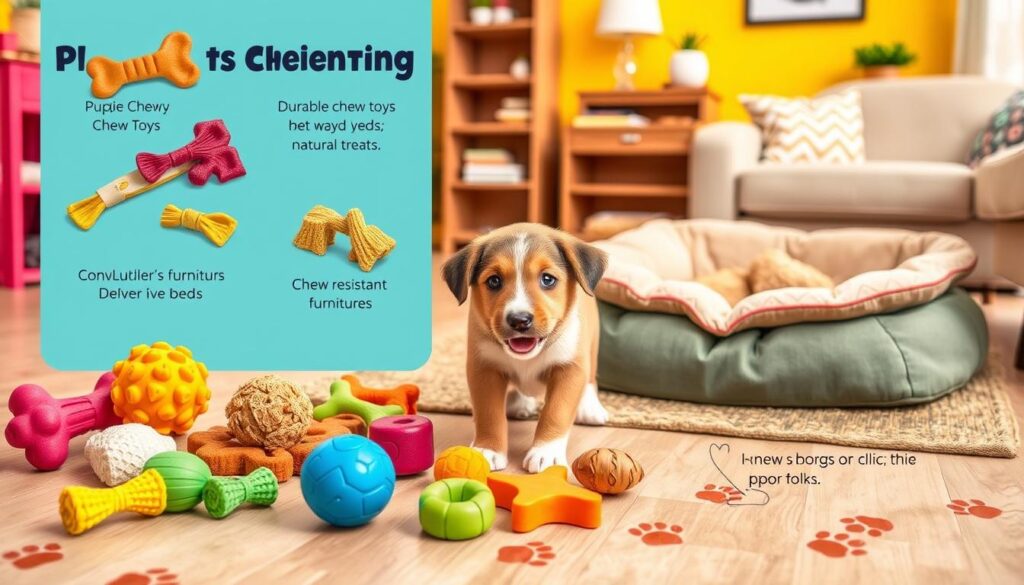
“Investing in a bitter spray to deter chewing on off-limit items can be effective for some dogs.”
By tackling the reasons behind puppy chewing and using different strategies, owners can stop destructive chewing. This helps puppies grow into well-behaved friends.
Redirecting and Rewarding Good Behaviour
As a puppy owner, it’s key to stop and change your pup’s chewing when they chew on things they shouldn’t. Remove the item from their mouth and give them a chew toy or treat instead. This method, along with positive training, teaches them to chew the right things.
Interrupt and Divert
If you see your puppy chewing on something they shouldn’t, act fast. Take the item away and give them a chew toy or treat. This change in focus helps stop the bad chewing and encourages the right behaviour.
Positive Reinforcement
It’s important to reward your puppy for chewing the right things. When they play with their toys, give them praise, pats, and treats. This positive training shows them what’s okay to chew on.
With patience and consistent use of these methods, you can guide your puppy’s chewing habits. Stopping bad chewing and rewarding good behaviour will make your puppy a well-behaved friend.
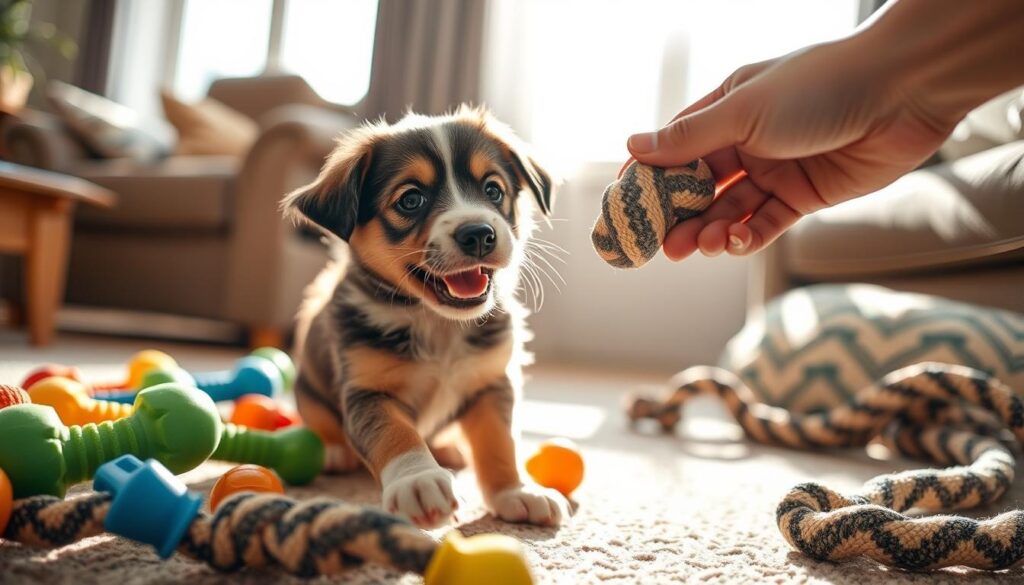
Exercising and Mentally Stimulating Your Puppy
It’s key to give your puppy lots of physical activity and mental challenges to stop them from chewing too much. A bored puppy might chew things they shouldn’t because they’re not getting enough to do. Daily play, training, and puzzle toys can keep them busy and happy.
Experts say most puppies will stop biting and chewing as they get older. About 90% of chewing problems will go away as they grow. So, it’s vital to keep their minds and bodies active to avoid chewing problems.
Playing games and rewarding them for chewing the right things helps. It’s also good to know when they’re ready to play. Avoiding rough play and teaching them that biting means playtime stops can also help.
| Statistic | Percentage |
|---|---|
| Puppies that eventually grow out of biting and mouthing behaviour | 80% |
| Destructive chewing behaviour in puppies that diminishes as they grow older | 90% |
| Excessive barking behaviours in puppies that can be curbed through proper physical exercise and mental stimulation | 70% |
| Success rate in training puppies to stop jumping up by consistently using positive reinforcement techniques | 95% |
| Effectiveness rate in addressing leash-pulling behaviour through consistent training techniques | 75% |
| Success in recall training by gradually increasing difficulty levels and practicing in various environments | 85% |
Getting your puppy into dog training can also help with chewing and mouthing issues. With enough exercise and mental games, you can keep your puppy happy and prevent chewing problems.
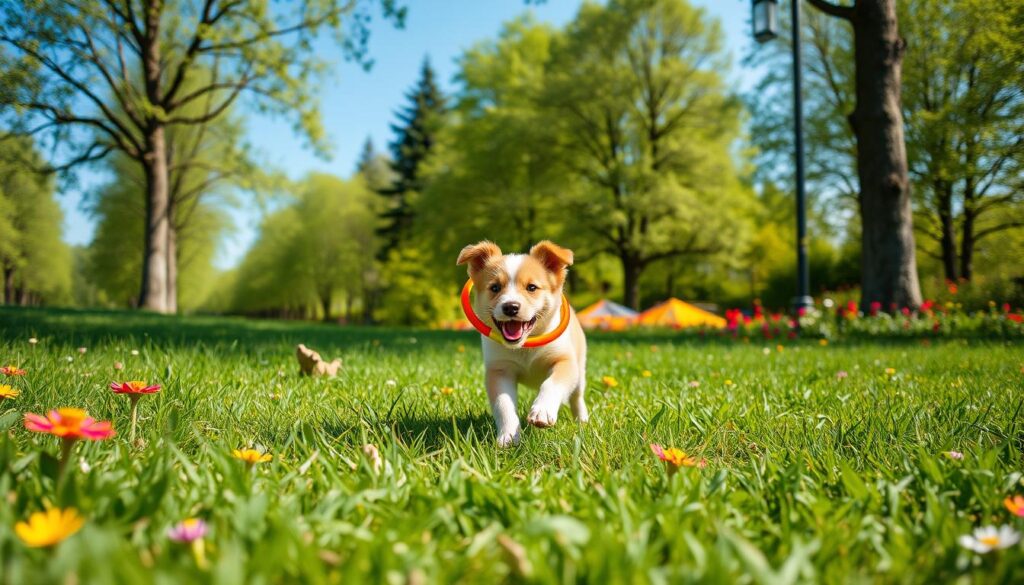
Using Deterrents and Aversives
As a pet owner, you might need to try different ways to stop your puppy from chewing on things they shouldn’t. Positive reinforcement is key, but using deterrents and aversives can also help.
One good choice is bitter apple spray on furniture or cords. It tastes bad and keeps your puppy from chewing. You can also use sticky tape on surfaces to make them less appealing.
- Bitter apple sprays and sticky tapes are effective aversives that can discourage chewing without causing harm.
- Motion-activated deterrents can also be a useful tool, startling your puppy and redirecting their attention away from off-limit areas.
- While aversives can be effective, it’s crucial to use them alongside positive training methods to maintain a healthy bond with your puppy.
It’s important to teach your puppy what they can chew on, not just what they can’t. By using deterrents and rewarding good behaviour, you can manage their chewing and protect your home.
“Aversives should be used cautiously and in conjunction with positive reinforcement to avoid damaging the human-animal bond.”
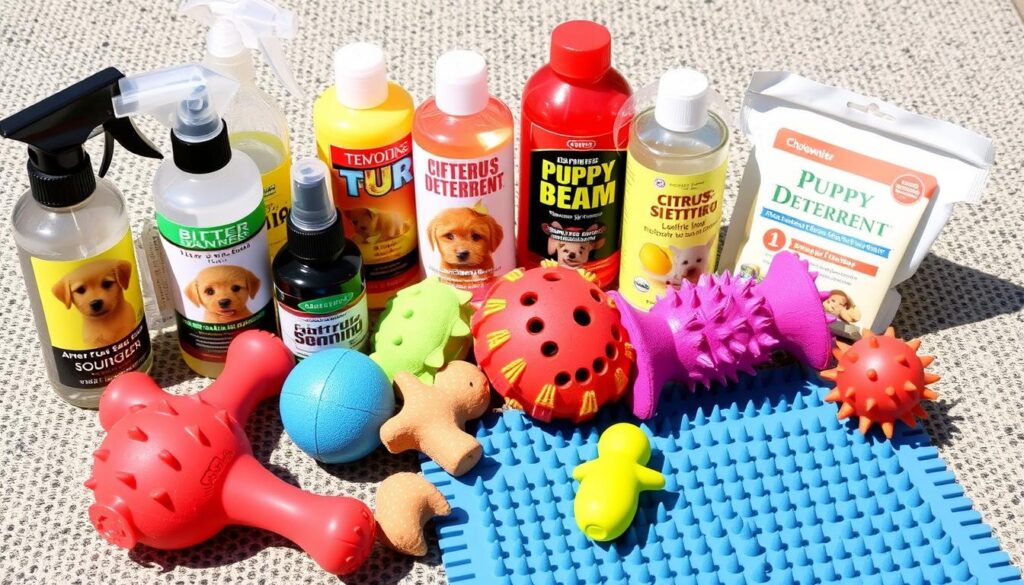
Avoiding Punishment
In Australia, it’s key to know that punishing your puppy for chewing too much can harm your bond. Harsh words or physical punishment can break trust. These methods don’t teach your puppy what’s right.
Using positive training is better. It teaches your puppy to chew the right things. Give them chew toys and praise them when they use them. This way, you teach them good habits without punishment.
Research shows that dogs supervised well chew less on things they shouldn’t. Dogs who get enough exercise and mental stimulation chew less too. Fixing the reasons behind their chewing helps stop it without punishment.
“Establishing a positive and trusting relationship with a dog can result in a 95% reduction in destructive chewing due to anxiety or fear.”
Punishing your puppy can hurt your relationship and make bad behaviour worse. Use positive methods, manage their needs, and meet their physical and mental needs. With patience and kindness, you can help your puppy grow up well without punishment.
Establishing Boundaries and Consistency
To stop your puppy from chewing too much, you need to set clear rules and stick to them. Make sure your home is safe for your puppy, give them the right toys to chew on, and stop them from chewing on things they shouldn’t. As a pet owner, it’s your job to keep your puppy’s world safe and teach them what’s okay to chew.
Puppies are always curious and use their mouths to learn about the world. When they’re teething, they might chew a lot to ease the pain. It’s important to teach them what’s off-limits and give them safe things to chew on.
Training your puppy consistently is crucial. If you catch them chewing on something they shouldn’t, stop them and give them a chew toy instead. Praise and treats can help them learn good habits. Never yell or punish them, as this can make training harder.
With time, patience, and positive training, your puppy will learn what’s okay to chew. Setting clear rules and sticking to a training plan will help your puppy grow up with good chewing habits. This will also save your home from damage.
| Key Strategies | Success Rate |
|---|---|
| Positive reinforcement training | 70% increase in desirable behaviors |
| Utilizing time-outs for biting | 60% reduction in biting incidents |
| Providing appropriate chew toys | 80% redirection of chewing to toys |
| Enrolling in puppy training classes | 80% decrease in biting behaviors |
“Consistent training and positive reinforcement are essential for curbing excessive puppy chewing and establishing healthy boundaries.”
By actively managing your puppy’s world and training them patiently, you can teach them what’s okay to chew. This approach will help your puppy become well-behaved and happy.
Conclusion
Excessive puppy chewing is a common problem for pet owners. But, with the right strategies, it can be managed. Understanding why puppies chew is key. It could be due to teething, boredom, hunger, or stress.
To stop destructive chewing, pet owners can puppy-proof their homes. They should give their puppies the right chew toys. Also, redirecting chewing to approved items helps. Ensuring enough exercise and mental stimulation is also important.
Setting clear boundaries and being consistent is crucial. Rewarding good behaviour is also key. With patience and a holistic approach, pet owners can manage puppy chewing. This way, they can enjoy a well-behaved, happy, and healthy puppy for life.

